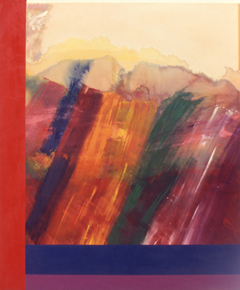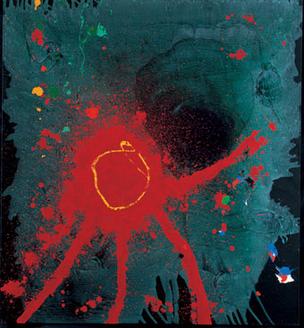
Patrick Joseph Caulfield,, was an English painter and printmaker known for his bold canvases, which often incorporated elements of photorealism within a pared-down scene. Examples of his work are Pottery and Still Life Ingredients.

Helen Frankenthaler was an American abstract expressionist painter. She was a major contributor to the history of postwar American painting. Having exhibited her work for over six decades, she spanned several generations of abstract painters while continuing to produce vital and ever-changing new work. Frankenthaler began exhibiting her large-scale abstract expressionist paintings in contemporary museums and galleries in the early 1950s. She was included in the 1964 Post-Painterly Abstraction exhibition curated by Clement Greenberg that introduced a newer generation of abstract painting that came to be known as color field. Born in Manhattan, she was influenced by Greenberg, Hans Hofmann, and Jackson Pollock's paintings. Her work has been the subject of several retrospective exhibitions, including a 1989 retrospective at the Museum of Modern Art in New York City, and been exhibited worldwide since the 1950s. In 2001, she was awarded the National Medal of Arts.

Hard-edge painting is painting in which abrupt transitions are found between color areas. Color areas are often of one unvarying color. The Hard-edge painting style is related to Geometric abstraction, Op Art, Post-painterly Abstraction, and Color Field painting.
John Keith Vaughan, was a British painter.
The Washington Color School, also known as the Washington, D.C., Color School, was an art movement starting during the 1950s–1970s in Washington, D.C., in the United States, built of abstract expressionist artists. The movement emerged during a time when society, the arts, and people were changing quickly. The founders of this movement are Morris Louis and Kenneth Noland, however four more artists were part of the initial art exhibition in 1965.
Kenneth Laurence Martin, was an English painter and sculptor who, with his wife Mary Martin and Victor Pasmore, was a leading figure in the revival of Constructivism.
Geoffrey Arthur Tibble was an English artist prominent in the Objective Abstraction movement.

Ronnie Landfield is an American abstract painter. During his early career from the mid-1960s through the 1970s his paintings were associated with Lyrical Abstraction, and he was represented by the David Whitney Gallery and the André Emmerich Gallery.
Ivon Hitchens was an English painter who started exhibiting during the 1920s. He became part of the 'London Group' of artists and exhibited with them during the 1930s. His house was bombed in 1940 during World War II. Hitchens and his family abandoned London for the Sussex countryside, where he acquired a small area of woodland on Lavington Common, and lived there in a caravan, which he gradually augmented with a series of buildings. It was here that the artist further developed his fascination with the woodland subject matter, and this pre-occupation continued until the artist's death in 1979.

Lyrical abstraction is either of two related but distinct trends in Post-war Modernist painting:

John Hamilton Bush was a Canadian abstract painter. A member of Painters Eleven, his paintings are associated with the Color Field movement and Post-painterly Abstraction. Inspired by Henri Matisse and American abstract expressionist painters like Helen Frankenthaler and Morris Louis, Bush encapsulated joyful yet emotional feelings in his vibrant paintings, comparing them to jazz music. Clement Greenberg described him as a "supreme colorist", along with Kenneth Noland in 1984.
Tom Palin is a British painter.
Dan Christensen, was an American abstract painter He is best known for paintings that relate to Lyrical Abstraction, Color field painting, and Abstract expressionism.
Ray Mead (1921–1998) was a Canadian abstract expressionist painter and a member of the artists group known as Painters Eleven. In his work, he often used a high horizon line as a structural element.

John Hoyland RA was a London-based British artist. He was one of the country's leading abstract painters.

Bill Barrett is an American sculptor, painter and jeweller. He is considered a central figure in the second generation of American metal sculptors and is internationally known for his abstract sculptures in steel, aluminum and bronze.
Richard Irving Bowman (1918–2001) was an abstract painter who worked primarily in the San Francisco Bay Area. He painted in an idiosyncratic style inspired by transcendental visions of nature, exposure to surrealism and investigations into sub-atomic physics. He is considered one of the first fine artists to employ fluorescent paint, which he maintained embodied sub-atomic life energy, beginning in the early 1950s.
Arthur Lowe was a member of the Nottingham Society of Artists, exhibiting there first in 1898, exhibited twice at the Royal Academy, five times at the Royal Birmingham Society of Artists, four times at the Walker Art Gallery, Liverpool, 99 times at Nottingham Castle Museum and Gallery, Nottingham, and twice at the Royal Cambrian Academy. In 1936, aged over 70 years, he held his first London one-man show exhibiting more than 200 works at the New Burlington Galleries, London.

Alice Trumbull Mason (1904–1971) was an American artist, writer, and a founding member of the American Abstract Artists group (AAA) in New York City. Mason was recognized as a pioneer of [[American Abstraction.
Edgar Hubert (1906-1985) was a British abstract painter.












